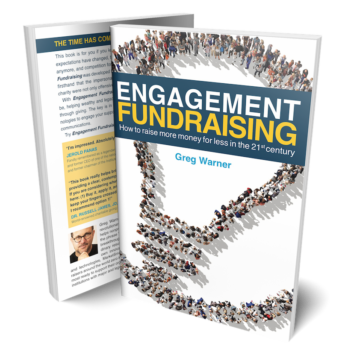We use cookies to ensure that we give you the best experience on our website. By continuing to use this site, you agree to our use of cookies in accordance with our Privacy Policy.
 Login
Login
Your Role
Challenges You Face
results
Learn
Resources
Company
Are Nonprofits Driving Gift Officers to Do Fundraising Activities that Don’t Work?


As a gift officer, do you sometimes feel like your administrators and leaders are directing you to perform fundraising activities that don’t actually seem to produce much revenue or donor lifetime value (the most important metric)?
In our years of observation as we’ve helped large nonprofit organizations increase their major and planned gift revenue through fundraising automation, we have found ourselves consistently running up against “existing procedures.” These often feel like a barrier to the more effective methods that our system has demonstrated to work better. You might know it by this phrase:
The way we’ve always done it.
Traditional Methods Aren’t Working Like They Should
As the field of major gifts fundraising has developed over the decades, nonprofits have learned a lot about how to identify, qualify, cultivate, and secure major gifts. And as with anything, various procedures and systems have been developed and clarified, because they seem to work.
But now, we’re at the dawn of a new era. The way things have been done for many years is no longer working. In fact, as we’ll show, it never worked as well as it may have seemed.
Too many gift officers are spending too much time performing tasks. Their performance is measured by activities. The metrics that define success do not in fact reflect real success as well as they should. Real success should be measured by dollars. The bigger gifts you’re winning, and the more often you’re winning them, the better your fundraising approach.
But too many gift officers are mired in activities, still performing tasks that seemed smart several decades ago as the field developed into a body of knowledge.
What we find now is a field of experts wasting far too much time on low quality leads, and failing to win the biggest gifts from the high quality leads.
6 Fundraising Activities to Stop Doing ASAP
So let’s look at some of the tasks the gift officers at your organization may still be doing and need to adjust. Or, they may be doing these while already knowing they’re not the best approach, but are clashing with their leadership over it.
1. Visits, Visits, and More Visits
Many fundraising consultants repeat the mantra to just get more visits with major donor prospects. Get out there. Keep calling. Keep making outreach. Get meetings. Just keep doing that as often as you can, and good things will happen.
There are numerous problems with this approach.
One of the biggest ones is that, for many organizations, lower-quality prospects are being added to your caseloads for a variety of reasons – not all of them justifiable. That leads to a situation where you may be succeeding in landing those meetings you’ve been told to get, but they’re with low quality prospects. These people may not have the wealth capacity to make a major gift. Or, it isn’t the best time in their lives to make one. In other cases, they just aren’t that passionate about your mission or organization.
So yes, you’re getting meetings, but many of them amount to nothing.
No – that is not a good use of your time. It’s a waste of time to pursue individual meetings with people who can’t or won’t make major gifts at levels that justify all the effort it takes to get those meetings.
Major gifts fundraising is not about scheduling the most meetings you can make happen.
2. Using Activity Metrics to Judge Performance
Number of visits is just an activity. Suppose one gift officer makes 20 visits per month because that’s the quota set by their administrator, but they only raise $50,000 for the year. Another gift officer makes only 5 visits per month on average – some months with zero – but raises $1 million dollars. Is anyone going to complain about how many visits they made?
Actually, they might.
We heard a story from one fundraiser who was reprimanded for failing to reach the required number of visits set by her administrator. One of her fellow fundraisers was commended for meeting it. But when she looked at the numbers that matter – revenue (and lifetime value)– she had generated five times more than the other fundraiser, who hadn’t raised enough to cover her own salary. And her donors’ lifetime value was tremendous.
Most other activity metrics aren’t good measures of performance either.
What matters is lifetime value (essentially number of major gifts and revenue) generated. And here are some other metrics you can measure that serve that purpose.
3. Having No Intentionality for the Visit
Why do you want visits with donors? Sometimes you get the sense that some board members and administrators think gift officers have the ability to form a magical connection with donors once they’re in the room with them. There is some particular combination of words you know how to say, or a persuasive emotional power you possess, that just results in major gifts.
We all know that isn’t true. Big gifts don’t just magically happen.
But then, what is the point of having meetings with major donor prospects? Do you know? Does your administrator know?
More importantly – does the donor know?
If the donor doesn’t know the point of the meeting they’re about to have with you, they might not see it as very important. This is one reason people cancel or reschedule meetings. It also makes them enter the meeting with apprehension, suspicion, and uncertainty. Those aren’t the emotions that lead to people giving their most generous gift.
The donor and whoever is meeting with them need to know why you’re having this meeting. And not every meeting’s purpose is to make a gift, as you’ll see in a bit. Usually an initial, purposeful meeting will involve getting to know one another to determine whether there’s a reason to meet again. Let your supporters know that’s why you’d like to meet and they’ll be more likely to grant you an opportunity to come together.
4. Entering Meetings with Assumptions
Do you have a script or formula for what to do during donor meetings based on what you think you know already? If so – burn it.
Some donors are ready to talk about giving. Some aren’t. Some donors care about their legacy. Some don’t. Some give because their family has always given and they want to continue the legacy. Others give because a family member was greatly impacted by the work of your organization. These are vastly different motives for giving.
Every donor is different. You just can’t know what you don’t know.
Lots of so-called experts recommend you develop a plan before you meet. That’s not right. You need to do your research first, and you need to determine what questions you might want to ask.
Sure, eventually you need an individual plan that is strategic and specific to each donor. Their needs, desires, interests, and passions. Their questions, worries, and considerations. But, frankly speaking, you need to develop that plan with them—not in secret with your organization’s staff or leaders. Transparency is key for building trust. If you want to land five, six, seven, and eight-figure gifts, invite your supporters into the process of developing a Roadmap® so they can find meaning through sharing.
Once you have, together, customized a strategic plan for their deeper engagement, involvement and (possibly) their giving, you won’t need to have nearly as many meetings to land more and bigger major gifts.
5. Prioritizing Quantity over Quality
One great meeting with a billionaire who cares about your mission and wants to give is worth way more of your time than a hundred meetings with people who aren’t truly capable of giving at a high level, or ready. Same goes for people who aren’t passionate about your mission.
What matters is who you are meeting with, not how many. You want to meet with passionate people (about your cause) who have capacity to give according to them (not wealth screening) and are ready to meet with you.
This is really kind of a summary of all the previous points so far. With customized planning based on the personal information freely shared by each donor via fundraising automation, a clear purpose for each meeting that is known by both donor and fundraiser, and less concern for reaching a meeting quota, you’ll be putting quality before quantity and focusing on the right metrics.
6. Asking for Money at First Sight
Do you believe in love at first sight? Maybe, but hopefully not. Will people donate at first sight? Most certainly not when it comes to major gifts, unless there’s an emergency or the timing is right for them.
So why do gift officers sometimes get pressured to ‘just ask’ for a gift, because ‘you never know’? This is a very poor giving experience for the donor, to be ambushed or blindsided by a completely unexpected request for an enormous financial gift during your first meeting with them.
It is driven by a popular fundraising myth claiming that the only reason most people don’t give is because they weren’t asked. It’s simply not true.
The truth is, people don’t give because they weren’t asked in the right way, at the right time, from the right person, for reasons that matter to them, and for a reasonable and particular amount that is realistic and hopefully aspirational to them. That doesn’t fit as well on a bumper sticker, but it’s far more accurate.
As we like to say at MarketSmart, drive-by solicitations don’t work.
What to Do Instead of Fundraising Activities that Don’t Work
Instead of all these inefficient and unproductive activities – which are driven by a poor understanding of donors and how major gifts fundraising works – consider a better approach.
What if you could conduct far more of your donor discovery and qualification steps before you even meet with a donor?
This is what our Engagement Fundraising system makes possible. MarketSmart exists to multiply and scale up the number of donors and prospects you can be engaging with, but without needing any additional staff to do it.
With fundraising automation software, you can continually and respectfully communicate with donors. Over time, they will reveal and share information (as they choose) through surveys and other digital communication that is automated using an AI-style approach that customizes the experience for each donor.
As they share that information and you learn more about them, you’ll gain a clear picture of which donors are ready and interested in meeting to discuss engaging more deeply in consideration of making a gift. With Engagement Fundraising you’ll know their reasons for giving, their wealth capacity, and their readiness—all according to them. That makes nearly all your meetings productive and positive experiences for everyone. And it results in more and bigger gifts, with far fewer meetings and wild goose chases.
How well does our system work?
Well, we offer a 10:1 ROI guarantee, and we have an ever-growing list of organizations very happy with their results.
Watch this video to learn more about using Engagement Fundraising automation software.
Related Resources:
- Don’t Just “Find” Donors; Build Relationships for Lasting Impact
- 4 Primal Motives for Major Gifts – the REAL Reasons People Make Transformational Gifts
- How Many Major Donors Are You Overlooking Right Under Your Nose?
- Major Donor Retention – What’s Holding It Back?
LIKE THIS BLOG POST? SHARE IT AND/OR LEAVE YOUR COMMENTS BELOW!
Get smarter with the SmartIdeas blog
Subscribe to our blog today and get actionable fundraising ideas delivered straight to your inbox!
